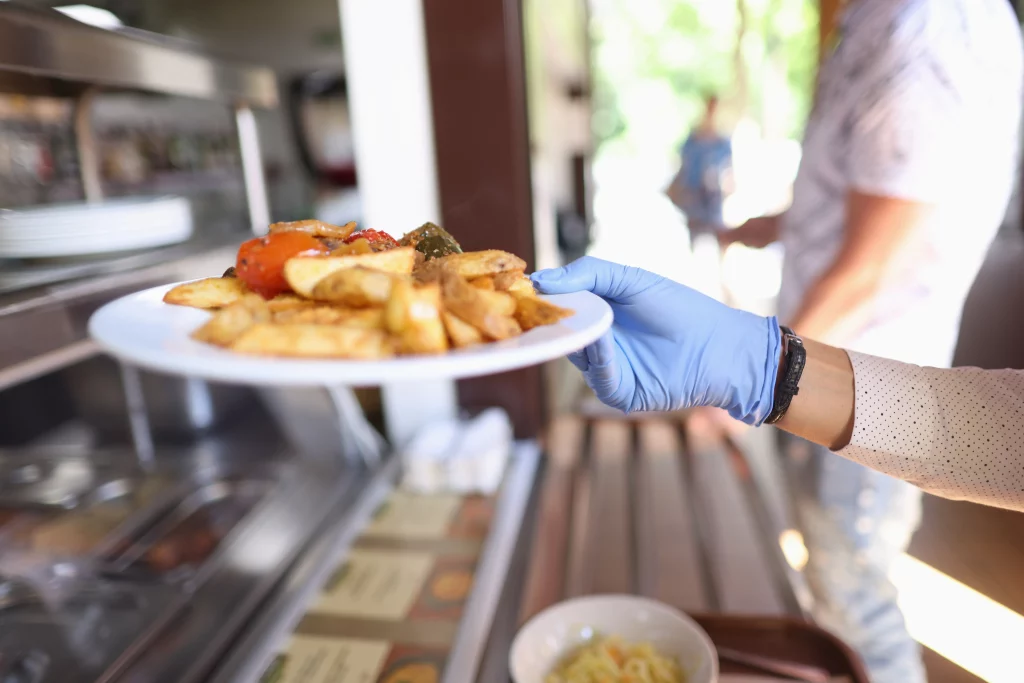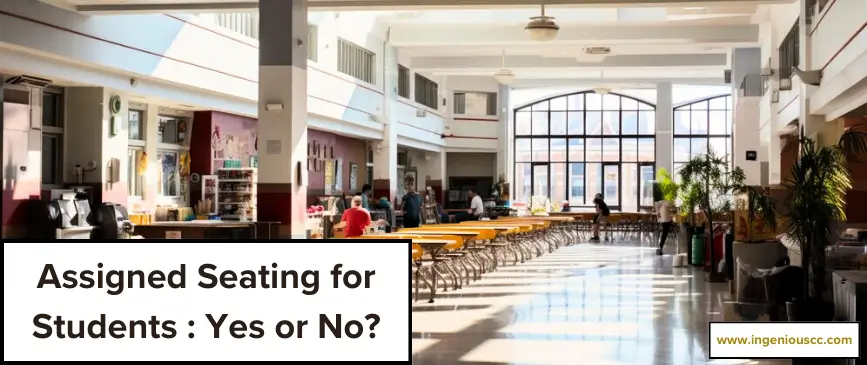Introduction
School cafeterias are not just places where students eat; they’re important for keeping everyone healthy. And making sure the food is safe is a big part of that.
From how meals are made to handling leftovers, every step is extremely crucial.
Therefore, in this article, we’ll look at the basics of food safety in school cafeterias.
We’ll talk about why good hygiene matters, how to store food safely, and why students play a key role in keeping things safe and sound.
So, without further ado, let’s explore the simple steps that make school lunches tasty and safe for everyone.
Key Takeaways
- Ensuring food safety in school cafeterias is vital for the health of students. Good hygiene, safe storage, and proper handling are essential to prevent foodborne illnesses.
- Involving students in food safety practices through visual aids, hands-on activities, and campaigns develops awareness and a sense of responsibility.
- Implementing portion control, offering customizable options, and regular menu reviews are effective strategies to minimize food wastage in cafeterias.
- Schools can contribute to their community by establishing donation programs, reducing food wastage, and supporting local charities.
The Importance of Food Safety in School Cafeterias
Ensuring food safety in school cafeterias is important because it directly affects students’ health. Kids and teens are more likely to get sick from unsafe food, so we have to be extra careful.
If we don’t follow good hygiene practices, it can lead to outbreaks of illnesses. This means more students might get sick, miss school, and struggle to concentrate in class. So, keeping food safe isn’t just about health; it’s about ensuring students do well in their studies and attend school regularly.
But it goes even further. If students get sick from the food, it can impact the school’s reputation quite negatively. Parents and the community might lose trust in the school.
On the other hand, if a school sticks to high food safety standards, it shows that it cares about its students, which certainly builds a positive reputation, and everyone feels confident that students are well taken care of.
That’s why ensuring safe food in school cafeterias is a big deal for keeping students healthy, happy, and ready to learn.
The Importance of Good Hygiene
Maintaining good hygiene in school cafeterias is a top priority to protect students from harmful bacteria and contaminants. Simple yet crucial practices, like proper handwashing, play a big role in preventing the spread of illnesses. Food handlers should make it a routine to wash their hands before they start work, after handling food, money, or using the bathroom.
Creating a culture of food safety in schools involves educating staff about the right way to handle food. This includes how they handle the food and take care of their uniforms and aprons. Daily cleaning and changing into fresh protective clothing, especially if it gets dirty, are essential to ensure food safety.
Wearing hair restraints while preparing food might seem small, but maintaining hygiene standards goes a long way. Additionally, when using disposable gloves, washing hands before and after putting them on is crucial, as changing gloves if they get dirty and switching them every two to four hours.
One often overlooked but vital aspect is to avoid working when sick, particularly if you have symptoms of a foodborne illness. These small actions add up to a big difference in protecting the health of everyone in the school community.
Safe Food Storage and Display
Storing and showing off food safely in school cafeterias is essential to keep our students healthy. Think of it as shielding our food against bad bacteria, which stops them from causing trouble.
When it comes to foods like meat, eggs, or dairy, we’ve got to refrigerate them fast. This keeps bacteria away, specifically in that Temperature Danger Zone (between 4°C to 60°C) where they love to party. High-risk foods have a time limit of no more than two hours at room temperature, considering transport, delivery, and prep time.
Keep raw meat under ready-to-eat foods, use sealed containers, and lift dry goods off the ground to keep pests away.
Hot foods need to stay hot, above 60°C. That means warming up our equipment and ensuring the food is cooked or reheated to at least 74°C. Cold foods should stay cool, at 4°C or below, to keep risky bacteria out of the picture.
For buffet-style foods, add an extra layer of protection. Seal them up or use the right utensils to avoid bare hands touching the food.
Safe Food Handling
In school cafeterias, keeping students healthy is all about handling food safely. We don’t want anyone getting sick, so make sure to follow some important rules.
It all starts with sticking to the guidelines. This means keeping perishable items at the right temperatures to avoid nasty bacteria. Another big rule is stopping things from mixing up, as you don’t want one thing’s germs getting into another.
Most importantly, your staff members should be trained to handle food just right, ensuring it’s cooked, cooled, and reheated properly. This way, every meal served is not just yummy but safe too.
Best Practice to Dispose of Leftover Foods
To tackle leftover foods in school cafeterias, adopting smart practices is key. Here are some effective approaches:
Establish Donation Programs:
Encouraging the donation of edible surplus food is a win-win. It not only helps minimize food wastage but also positively impacts the community. Schools can redirect excess food to those who need it most by collaborating with local charities or community organizations.
Composting Systems:
Introducing composting systems for food scraps and non-edible leftovers is a fantastic way to reduce environmental impact. Beyond being eco-friendly, composting creates nutrient-rich soil that can benefit school gardens and support local green initiatives.
It’s a simple yet powerful solution.
Utilize Waste Tracking Systems:
Incorporating technology to monitor and analyze food waste trends is a game-changer. By understanding patterns, cafeteria staff can adjust meal planning and preparation processes to match actual consumption. This minimizes excess leftovers and ensures that resources are used efficiently.
Tips to Reduce Wastage
Reducing food wastage in school cafeterias is a goal that benefits everyone. Here are practical tips to make it happen:
| Tip | Impact |
| Implement Portion Control | Minimizes uneaten food and reduces overall food waste |
| Offer Customizable Options | Allows students to choose preferred items, reducing plate waste |
| Regularly Monitor Menu Planning | Aligns menus with student preferences, minimizing leftovers |
| Educate Students on Food Waste | Raises awareness, encouraging mindful consumption habits |
Implement Portion Control:
Encouraging cafeteria staff to serve controlled portion sizes is a smart move. You can significantly cut down on uneaten food by keeping an eye on what students eat and adjusting portions accordingly. It’s a simple step that can make a big difference.
Regularly Monitor and Adjust Menu Planning:
Staying in tune with student preferences and consumption patterns is key. Regular menu reviews help cafeteria managers tweak offerings to match what students like. This proactive step ensures that the food prepared aligns with what students enjoy, which ultimately minimizes leftovers.
Educate Students on Food Waste:
Teaching students about the impact of food waste is a powerful tool. Integrating educational programs into the school curriculum raises awareness about the environmental and social consequences of wasting food. It’s about instilling a sense of responsibility and encouraging students to be mindful of their consumption habits.
Engaging Students in Food Safety
Getting students involved in food safety is key in creating awareness and responsibility in school cafeterias. Here’s how we can make it engaging:
Use Visual Aids:
Pictures speak louder than words. Using posters or digital displays is a great way to show students the essential food safety practices. It’s clear, simple, and keeps everyone on the same page.
Hands-On Activities:
Sometimes, learning by doing is the best way. Hands-on activities, like food safety demonstrations and interactive workshops, give students practical knowledge and skills. It’s a fun and informative game that reinforces the importance of safe food handling.
Student Involvement in Campaigns:
When students take the lead, magic happens. Involving them in planning and executing food safety campaigns gives them a sense of ownership and responsibility.
Regular Communication:
Keeping everyone in the loop is crucial. Regular announcements, newsletters, or discussions help reinforce awareness of food safety guidelines. It’s a simple but effective way to ensure everyone is on board.
Importance of Aprons and Gloves in Food Safety
Understanding why aprons and gloves are crucial is like grasping the basics of kitchen safety. Here’s why these simple things matter so much:
Aprons act like shields, keeping our clothes safe from any lurking germs in food. It wouldn’t be wrong to call them the frontline defenders who ensure nothing on our clothes ends in the food.
On the other hand, gloves play a key role by creating a barrier between our hands and the food. This means fewer germs from our hands end up in what we’re preparing. Using gloves properly, particularly with ready-to-eat foods, adds that extra layer of protection.
And when we combine both of them, it becomes a powerful duo that keeps our hands clean and our food safe. It’s a simple yet effective way to minimize the risk of foodborne illnesses and make our kitchen safe.
Food Safety Practices in School Cafeterias
| Food Safety Practice | Importance |
| Proper Food Handling | Minimizes the risk of foodborne illnesses |
| Safe Food Storage and Display | Prevents bacterial growth and maintains freshness |
| Engaging Students in Safety | Fosters awareness and a sense of responsibility |
| Aprons and Gloves Usage | Prevents contamination and promotes personal hygiene |
Concluding Thoughts
Keeping our school cafeterias safe is a team effort. Each step counts from using aprons and gloves to reducing wastage and getting students involved. By following these practices, we ensure that our students enjoy delicious and safe meals. It’s a recipe for a healthy, happy school community. So, let’s keep the kitchens clean, the food safe, and our students thriving.
FAQs
How can schools encourage students to adopt safer food consumption habits?
Schools can encourage safer food consumption habits by integrating educational programs into the curriculum. These programs can raise awareness about the impacts of unsafe food practices on personal health and the community. Regular communication through announcements, newsletters, or discussions also helps reinforce the importance of following food safety guidelines.
What role do customizable meal options play in reducing food wastage?
Customizable meal options empower students to choose only the items they prefer. When students can select foods they enjoy, there’s a higher likelihood that they will consume their entire meal. This approach minimizes the amount of uneaten food and contributes to a more efficient and less wasteful cafeteria environment.
Why is it important for students to understand the link between food safety and personal well-being?
Understanding the link between food safety and personal well-being motivates students to actively participate in maintaining a clean and safe cafeteria. When students recognize that following food safety practices directly impacts their health, they are more likely to adopt responsible behaviors, such as proper hand hygiene and careful food handling.



